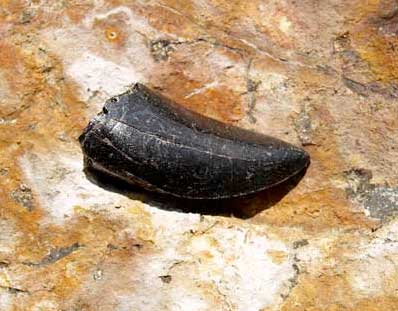Dinosaurs used to live in the arctic
You've heard of the spectacle: 65 million years ago, a large meteor hit the earth, causing volcanoes, smoke and dust to fill the space, and then the dinosaurs disappeared.
One theory is that the cold caused by the obscured sun is the cause of killing dinosaurs. However, a group of paleontologists headed by Pascal Godefroit, from the Belgian Royal Institute of Natural Sciences in Brussels, made another theory.Accordingly, some dinosaurs (presumably warm-blooded) have coped very well with near-freezing temperatures .
According to the team's latest discovery, some dinosaur fossils have been buried along the Kakanaut River today in northeastern Russia just a few million years before the disaster.According to calculations after subtracting the accreted continent, it is thought that this dinosaur has lived above 70 degrees north latitude, away from the Arctic Circle (66 degrees 30 minutes North).

A dinosaur tooth was discovered along the present Kakanaut River in northeastern Russia.The tooth shows the dinosaurs who once lived on the Arctic Circle.(Photo: Pascal Godefroit)
And they are not just lost individuals. Fossils including the dinosaur eggshell - were first discovered at such a high latitude - and also the evidence of a stable, reproductive population.
It is true that the Arctic is much warmer than it is now, but certainly their lives are not easy. The size and shape of fossil leaves found with dinosaur bones allows the Godefroit team to estimate the average temperature for the year to be 50 degrees F, and winter temperatures down to freezing.
There are many factors that kill dinosaurs. The dust in the atmosphere must have taken away the photosynthesis process of the plant, weakening the basis of the food chain and causing hunger, eventually leading to the extinction of the dinosaurs.
The study is described in detail in Naturwissenschaften.
- Arctic dinosaurs are only 20 years old
- What if dinosaurs live with humans?
- 10 weird, hard to imagine dinosaurs
- Newborn dinosaurs are only about one-third the size of a human being but have a very fast speed
- The land kept thousands of dinosaur footprints for 80 million years
- Dinosaurs used to live in the water
- Life of dinosaurs so far without extinction
- Meteors do not destroy all dinosaurs
- Interesting facts about animals living in the Arctic
- The dinosaurs were re-infected with helminths
- Humans used to live with dinosaurs 10,000 years ago?
- The discovery of fossil-covered dinosaur-covered fossils in America
 Discovered an ancient centipede fossil 99 million years old
Discovered an ancient centipede fossil 99 million years old Discovered bat-like dinosaurs in China
Discovered bat-like dinosaurs in China Discovered a 200-year-old bronze cannon of the coast
Discovered a 200-year-old bronze cannon of the coast Discover 305 million-year-old spider fossils
Discover 305 million-year-old spider fossils